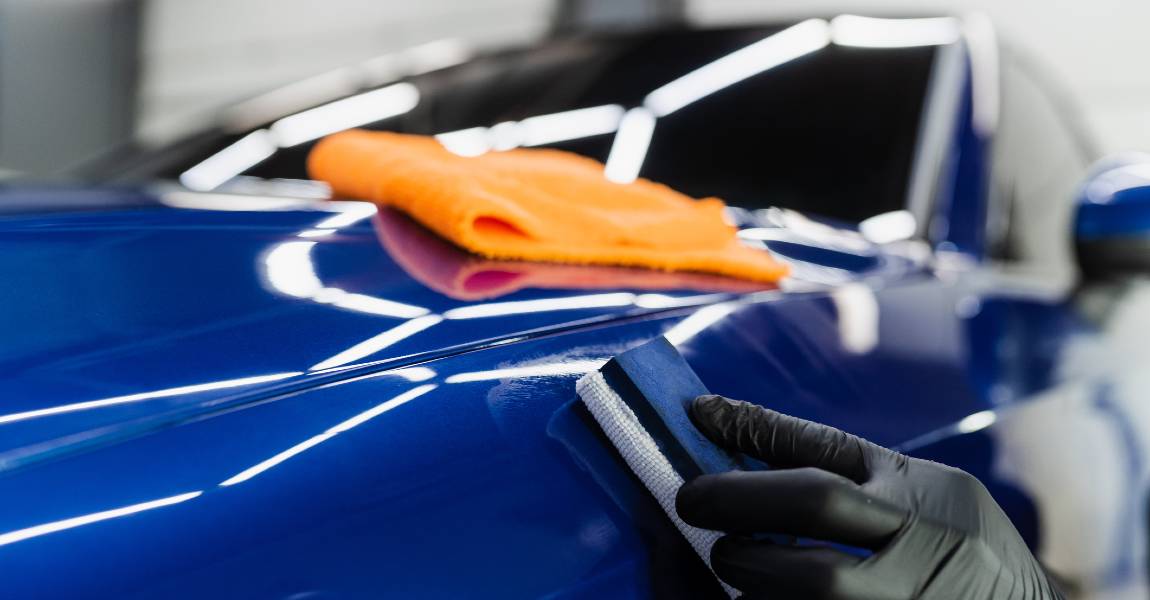How Ceramic Layer Secures Your Automobile's Paint and Keeps It Looking New
Ceramic coating has actually arised as a noticeable service for vehicle paint protection, providing a durable protection versus a variety of ecological risks. The ins and outs of how this innovation works and its benefits over traditional techniques necessitate a closer evaluation, disclosing compelling factors to consider this cutting-edge method for your automobile.
What Is Ceramic Layer?
Ceramic finish is often regarded as an advanced development in automotive paint security. ceramic coating. This advanced item is a liquid polymer that chemically bonds with the vehicle's manufacturing facility paint, developing a protective layer that boosts resilience and aesthetic allure. Unlike typical wax or sealers, which supply only short-term security, ceramic finishings provide lasting results, typically covering a number of years with appropriate maintenance
The primary components of ceramic coatings are silicon dioxide (SiO2) and titanium dioxide (TiO2), which add to their hydrophobic residential or commercial properties. This hydrophobic nature enables water to bead and roll off the surface area, efficiently stopping impurities like dust, crud, and bird droppings from sticking to the paint. As a result, vehicles treated with ceramic coatings call for much less frequent cleaning and are simpler to keep.
In addition, ceramic finishings provide UV security, which aids avoid oxidation and fading of the paint as a result of sun direct exposure. This aspect not only keeps the vehicle's visual charm but additionally adds to its resale value with time. In general, ceramic layers represent a substantial jump forward in the realm of auto care, using a durable solution for automobile proprietors seeking to protect their financial investment.
Just How Ceramic Covering Works
Just how does the process of ceramic finishing develop a formidable barrier against ecological hazards? Ceramic finishing contains a liquid polymer that chemically bonds with the manufacturing facility paint of a lorry. This bond develops a safety layer that is both hydrophobic and sturdy. The primary element of ceramic coatings is silica dioxide (SiO ₂), which offers premium solidity and resilience against scratches, UV rays, and other outside pollutants.
When used appropriately, the coating permeates the microscopic pores of the paint surface, creating a semi-permanent bond. This leads to a smooth, glossy finish that enhances the automobile's visual charm while all at once repelling water, dirt, and grime. The hydrophobic nature of the covering guarantees that pollutants slide off quickly, decreasing the frequency of cleaning and the likelihood of scratches throughout cleansing.

Advantages of Ceramic Coating
The application of ceramic finishing uses numerous advantages that substantially boost the defense and look of a vehicle's paint. One of the primary benefits is its capability to produce a robust, hydrophobic layer that fends off water, dirt, and other contaminants. This property not only maintains the surface cleaner for longer periods but also makes washing the lorry much easier and much less labor-intensive.
In addition, ceramic finishes provide superior protection versus dangerous UV rays, which can cause oxidation and fading see this gradually. ceramic coating. This UV resistance assists maintain the initial shade and gloss of the car's paint, thus preserving its visual charm for many years
Additionally, ceramic coatings are chemically immune, supplying security against acidic impurities such as bird droppings, tree sap, and roadway gunk. This resistance aids protect against etching and staining, which can compromise the honesty of the paint.
Last but not least, the sturdiness of ceramic finishings extends past conventional waxes and sealers, commonly enduring several years with correct maintenance. This durable security ultimately equates into price savings, as vehicle proprietors can reduce the regularity of reapplication and maintenance initiatives. Overall, ceramic finishes represent a substantial investment in automobile care.
Comparing Ceramic Coating to Standard Approaches
Typically forgotten in the mission for optimum car security, the contrast between ceramic finish and traditional techniques such as shaving and sealants exposes substantial differences in toughness, performance, and maintenance. Standard waxes generally supply a short-lived protective layer, commonly lasting only a few weeks to a number of months, while sealants can prolong this duration to a number of months. On the other hand, ceramic coatings provide a durable, durable shield that can withstand for numerous years when effectively used.
In terms of performance, ceramic finishings show remarkable hydrophobic properties, efficiently driving away water and impurities, which prevents dirt and grime from adhering to the surface area. This home not only improves the automobile's appearance however also simplifies the cleaning procedure. Typical waxes and sealers, while they might use some water resistance, do not match the level of security offered by ceramic coverings.
The maintenance regime for both alternatives deviates dramatically. While typical techniques need regular reapplication and upkeep, ceramic coatings are designed to hold up against the roughness of everyday driving with very little intervention, making them an extra effective option for vehicle enthusiasts looking for long-lasting protection. Inevitably, the selection between ceramic coating and traditional approaches pivots on the preferred level of defense and maintenance commitment.
Upkeep Tips for Ceramic Coated Cars
Keeping a ceramic coated auto needs a strategic technique to guarantee the long life of the protective layer. Make use of a pH-neutral shampoo and microfiber laundry mitts to prevent scraping the coating while effectively eliminating dust and check my reference pollutants.
In addition, prevent automatic auto cleans that make use of brushes, as these can compromise the click here now honesty of the ceramic finishing. Rather, go with a touchless laundry or a hand laundry. After cleaning, drying is important; use a high-quality microfiber towel to stop water spots.
Applying a ceramic-specific upkeep spray can boost the covering's hydrophobic properties and add an added layer of defense. This need to be done periodically, depending upon your driving problems.

Verdict
In conclusion, ceramic finish serves as an efficient safety step for auto paint, using a resilient obstacle against ecological damage and boosting the car's visual appeal. Taking on ceramic covering modern technology can considerably extend the life-span of a car's outside, ensuring it remains aesthetically attractive and well-protected.